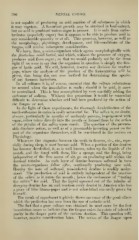Page 786 - My FlipBook
P. 786
796 DENTAL CARIES.
is not capable of producing an acid reaction of all substances in which
it may vegetate. A luxuriant growth may be obtained in beef-extract,
but no acid is produced unless sugar is present. It is only from carbo-
hydrates (especially sugar) that it appears to be able to produce acid in
any considerable quantity or at all. This question, however, as well as
the morphology, physiology, development, and life-conditions of the
fungus, will receive subsequent consideration.
We have, then, a micro-organism which agrees morphologically with
the Bacterium acidi laciici, and which, A\ithout the presence of oxygen^
produces acid from sugar ; so that we m^ouIcI probably not be far from
right if we were to say that the organism in question is simply the fun-
gus of lactic acid. We will, however, reserve our decision for another
page, where the analysis of the product of the fermentation will be
given, that being the. one sure method for determining the species
of any ferment bacterium.
In all cultures it is, of course, essential that the culture substratum
be neutral when the inoculation is made ; should it be acid, it must
be neutralized. This is best accomplished by very carefully adding the
carbonate of sodium. Without this precaution it would be somewhat
difficult to determine whether acid had been produced by the action of
the fungus or not.
In the light of these experiments, the thorough decalcification of the
tooth-substance in caries is easily accounted for. The saliva is, no doubt,
always, particularly in mouths of uncleanly persons, impregnated with
sugar, either taken directly into the mouth or formed there by the action
of the ptyalin of the saliva upon starch. The question of the presum-
able diastatic action, as well as of a presumable inverting power on the
part of the organisms themselves, Avill be considered in the section on
Physiology.
Wherever this stagnates between the teeth in fissures, etc., etc., espe-
cially during sleep, it 7nnst become acid. When a portion of the dentine
has become decalcified, it, as is well known, takes up the liquids of the
mouth, and the fungi with them, like a sponge, and the fungi, being
independent of the free access of air, go on producing acid within the
dentinal tubules. As each layer of dentine becomes softened in turn
the micro-organisms follow offer, continually producing new acid.
Hereby the zone of softened, non-infected dentine is readily under-
stood. The production of acid is entirely independent of the reaction
of the saliva as it enters the mouth ; hence the uselessness of " testing
the saliva" for acid. That the liquid squeezed out of the tubules of
decaj/inr/ dentine lias an acid reaction every dentist in America who has
a piece of blue litnms-paper and is not color-blind can easily prove for
himself.
The result of experiment 6 ])lainly shows one cause of the good effects
which the profession has seen from the use of carbolic acid.
The fact that a pure culture was obtained in most cases by the first
inoculation seems to indicate that the fungus exists in a state of tolerable
purity in the deeper parts of the carious dentine. This question will,
however, receive consideration later. The action of the fungus upon


